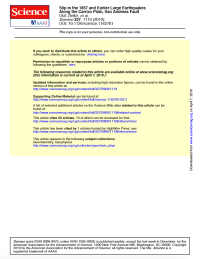The moment magnitude (Mw) 7.9 Fort Tejon earthquake of 1857, with a ~350-kilometer-long surface rupture, was the most recent major earthquake along the south-central San Andreas Fault, California. Based on previous measurements of its surface slip distribution, rupture along the ~60-kilometer-long Carrizo segment was thought to control the recurrence of 1857-like earthquakes. New high-resolution topographic data show that the average slip along the Carrizo segment during the 1857 event was 5.3 T 1.4 meters, eliminating the core assumption for a linkage between Carrizo segment rupture and recurrence of major earthquakes along the south-central San Andreas Fault. Earthquake slip along the Carrizo segment may recur in earthquake clusters with cumulative slip of ~5 meters.
Zielke, O., Arrowsmith, J R., Ludwig L G., Akciz, S.O., 2010, Slip in the 1857 and Earlier Large Earthquakes Along the Carrizo Plain, San Andreas Fault: Science, v. 327, 5969, p. 1119-1122.


